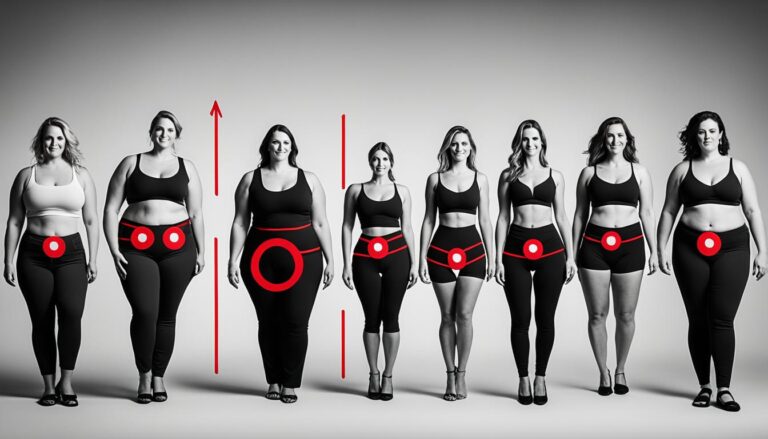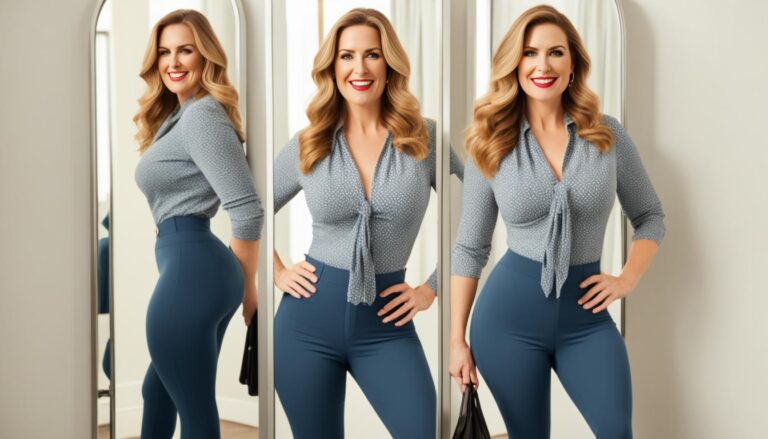Why do high-waisted jeans hurt my stomach?
Have you ever wondered why those trendy high-waisted jeans you love so much seem to cause discomfort and stomach pain? Despite their popularity, many people find that wearing high-waisted jeans can be a literal pain in the gut. But what exactly is causing this discomfort? Could it be the fit, the style, or something else entirely? In this article, we will delve into the reasons behind the discomfort caused by high-waisted jeans and provide you with solutions to alleviate the pain. Get ready to discover the truth behind your favorite pair of jeans and find out how to make your fashion choices more comfortable and enjoyable.
Key Takeaways:
- High-waisted jeans can cause discomfort and stomach pain for some individuals.
- The tight waistband of high-waisted jeans can put pressure on the abdomen and lead to digestive issues.
- Standing jeans and sitting jeans have different waistband designs that can affect comfort while sitting.
- Tight pants, including high-waisted jeans, can restrict movement and affect circulation, breathing, and digestion.
- Choosing clothing made from natural and breathable fabrics can contribute to overall comfort and skin health.
The Impact of Standing Jeans on Digestion
Standing jeans, also known as tight pants, can have a detrimental effect on your digestion. The pressure exerted by these tight-fitting pants on your abdomen can lead to various digestive issues and discomfort. When you wear standing jeans, the tightness pushes your stomach and intestines upward toward your esophagus, which can increase the likelihood of experiencing acid reflux, heartburn, and other digestive problems. If you already have underlying gastrointestinal conditions, such as irritable bowel syndrome (IBS), wearing tight clothing like standing jeans can exacerbate your symptoms and lead to further discomfort.
It is crucial to be mindful of your body’s signals and avoid wearing tight jeans if you are already dealing with bloating or abdominal discomfort. Paying attention to your clothing choices and opting for more comfortable options can help alleviate any digestive issues associated with standing jeans.
Effects of Tight Pants on Digestion – Key Points:
- Standing jeans, or tight pants, can put pressure on the abdomen.
- This pressure can push the stomach and intestines upward toward the esophagus.
- This can lead to acid reflux, heartburn, and digestive discomfort.
- People with chronic gastrointestinal conditions like IBS may experience worsened symptoms when wearing tight clothing.
- Avoid wearing standing jeans if you are already experiencing bloating or abdominal discomfort.
Quote:
“Listen to your body and avoid wearing tight jeans if you are already experiencing bloating or abdominal discomfort.” – Dr. Jessica Carter, Gastroenterologist
| Tight Pants | Impact on Digestion |
|---|---|
| Standing jeans | Increased pressure on the abdomen, leading to acid reflux, heartburn, and digestive discomfort |
| Restrictive waistbands | Potential digestive issues like constipation, bloating, and diarrhea |
| Low-rise jeans | Compression of the lower abdomen and discomfort in the intestines and hips |
The Difference Between Standing Jeans and Sitting Jeans
When it comes to jeans, not all fits are created equal. Understanding the difference between standing jeans and sitting jeans can help you find the perfect pair that offers both style and comfort.
Standing jeans are designed to look great when you’re on your feet, but they may come with some uncomfortable side effects when it’s time to sit down. These jeans often have a waistband that digs into your lower abdomen, causing discomfort and even pain. This tight waistband can make sitting for long periods a struggle and leave you feeling restricted.
Sitting jeans, on the other hand, are specially crafted with a more comfortable and flexible waistband that allows for easier movement and sitting. These jeans prioritize your comfort, ensuring that you don’t have to sacrifice style for functionality. The waistband is designed to sit comfortably on your hips without digging into your lower abdomen, providing a more relaxed fit for all-day wear.
To determine if a pair of jeans is suitable for sitting, you can perform a simple “sitting test”. Try sitting down in the jeans and pay attention to how the waistband feels. If it cuts into your lower abdomen or causes discomfort, you can conclude that they are standing jeans. On the other hand, if the waistband feels comfortable and doesn’t dig in, you can confidently say that they are sitting jeans.
So, whether you’re running errands, working at your desk, or going out for a night on the town, it’s important to choose jeans that prioritize both style and comfort. Opting for sitting jeans will ensure that you can look great and feel comfortable no matter what the day brings.
| Sitting Jeans | Standing Jeans |
|---|---|
| Flexible and comfortable waistband | Tight and restrictive waistband |
| Allows for easy movement and sitting | Digs into lower abdomen when sitting |
| Designed for all-day comfort | May cause discomfort and pain when sitting |
Choose sitting jeans for a stylish and comfortable denim option that will keep you feeling great all day long.
How Tight Pants Affect the Stomach and Intestines
When it comes to fashion, tight pants, including high-waisted jeans, have gained popularity for their stylish appearance. However, wearing these types of pants can have an impact on your stomach and intestines. The pressure exerted by tight pants on the abdomen can lead to various digestive issues, including acid reflux, heartburn, and discomfort in digestion.
The pressure caused by tight pants can disrupt the normal functioning of the digestive system. The constriction of the waistband and the compression of the abdomen can cause the stomach and intestines to be pushed upward, increasing the likelihood of acid reflux and heartburn, especially if you already have a condition like gastroesophageal reflux disease (GERD).
This added pressure on the abdomen can also impede proper digestion. The digestive process relies on the movement of food through the stomach and intestines, facilitated by muscle contractions. However, wearing tight pants can restrict the natural movements of these organs, leading to a sluggish digestion process and potential discomfort.
Individuals with pre-existing gastrointestinal conditions, such as irritable bowel syndrome (IBS), may be particularly sensitive to the effects of tight pants. The added pressure can exacerbate their symptoms, causing bloating, gas, and abdominal pain.
To understand the impact of tight pants on your digestive system, it’s essential to listen to your body. If you experience bloating, abdominal discomfort, or notice an increase in acid reflux and heartburn while wearing tight pants, it may be best to avoid them and opt for looser-fitting clothing.
Remember, fashion should never compromise your comfort and well-being. Prioritize your digestive health and choose clothing that allows for free movement and does not place excessive pressure on your abdomen.
Tips for Alleviating Stomach Discomfort from High-Waisted Jeans
When it comes to wearing high-waisted jeans, stomach discomfort can be a common issue for many individuals. The pressure exerted by the jeans on the abdomen can cause bloating, heartburn, and general discomfort. However, there are several tips you can follow to alleviate these symptoms and make your high-waisted jeans experience more enjoyable.
- Watch your food choices: Certain foods are known to cause bloating and heartburn, so it’s a good idea to avoid them when wearing high-waisted jeans. Garlic, onions, and green leafy vegetables are common culprits. Opt for lighter, easily digestible meals to minimize stomach disruption.
- Prioritize gut health: A healthy gut can help alleviate bloating and reduce stomach discomfort. Incorporate a variety of whole plant foods into your diet, such as fruits, vegetables, whole grains, and legumes. These foods are rich in fiber and promote healthy digestion.
- Maintain an active lifestyle: Regular physical activity can aid in digestion by stimulating the muscles of the digestive system. Engage in activities that you enjoy, such as walking, yoga, or dancing, to keep your digestive system functioning optimally.
- Get enough sleep: Inadequate sleep can disrupt your digestion and contribute to stomach discomfort. Aim for seven to eight hours of quality sleep each night to support overall gut health.
Remember that everyone’s body is unique, so it’s essential to listen to your own needs and make personalized choices. What works for someone else may not work for you. Pay attention to how your body reacts to different foods and clothing choices, and make adjustments accordingly. By prioritizing your gut health and making mindful lifestyle choices, you can alleviate stomach discomfort and enjoy wearing your high-waisted jeans with confidence.
The Impact of Form-Fitting Clothes on Body Movement
Form-fitting clothes, including high-waisted jeans, can have a significant impact on your body’s movement, affecting various aspects of your overall well-being.
Restricted Movement: Tight and form-fitting clothes can limit your range of motion, making it challenging to move freely. This restriction can hinder your ability to perform daily activities comfortably, whether it’s bending down, reaching up, or simply walking with ease.
Circulation: When clothes are too tight, they can constrict blood flow, particularly around areas with elastic bands such as waistbands and cuffs. This restriction can affect circulation, leading to discomfort and even potential health issues in the long run.
“Tight clothing can limit the expansion of the diaphragm and lungs, leading to shallow breathing and reduced oxygen intake.”
Skin Irritation: Form-fitting clothes can cause friction against the skin, resulting in skin irritation, rashes, and redness. This is particularly common in areas where the fabric rubs against the skin, such as the waistline or underarms.
Strain: Wearing tight clothes for extended periods can put strain on your muscles and joints. This strain can lead to discomfort, muscle fatigue, and even potential injuries, especially in areas such as the back and shoulders.
“Tight clothing can put strain on your muscles and potentially lead to back pain.”
Breathing: Form-fitting clothes, especially around the waist and chest, can restrict the expansion of the diaphragm and lungs. This limitation can result in shallow breathing, reducing oxygen intake and potentially impacting your overall energy levels and well-being.
Digestion: Tight clothing, such as high-waisted jeans, can put pressure on your abdomen, potentially affecting digestion. This pressure can disrupt the normal flow of digestion, leading to discomfort, bloating, and even digestive issues like acid reflux or indigestion.
To ensure optimal body movement and comfort, it’s essential to prioritize clothing choices that allow for free movement and circulation. Select clothing with looser fits or fabrics that offer more flexibility, such as stretchy materials or styles with elastic waistbands. Taking breaks from form-fitting clothes and giving your body room to breathe can have a significant positive impact on your overall well-being.

The Impact of Body-Conscious Clothing on Breathing and Mobility
Body-conscious clothing, such as shapewear and skinny jeans, can have significant effects on your breathing and mobility. Shapewear, resembling corsets, can restrict the movement of your diaphragm and limit expansion of your lungs, thereby affecting breathability. Similarly, skinny jeans that lack stretch can impede your hip and knee mobility, altering your walking patterns and potentially leading to injury.
When it comes to body-conscious clothing, it’s crucial to strike a balance between compression and comfort. It’s essential to prioritize breathability and flexibility in your fabric choices to ensure optimal comfort and prevent any adverse effects on your breathing and mobility.
The Breathability Factor
The issue with shapewear and similar body-conscious garments is that they can limit diaphragmatic movement, reducing the capacity of your lungs to expand. This restriction can make breathing feel constricted and may lead to shallow breathing, impacting oxygen intake.
It is advisable to choose body-conscious clothing made from breathable and lightweight fabrics, allowing air to circulate properly and keeping you comfortable throughout the day.
Restricted Hip and Knee Mobility
Skinny jeans without adequate stretch can restrict your hip and knee mobility, limiting your range of motion. This alteration in movement patterns can have long-term consequences, potentially leading to muscle imbalances and even injury.
To maintain optimal hip and knee mobility, consider opting for jeans with a bit of stretch or cuts that allow for more movement. This will help you stay comfortable and prevent any limitations on your daily activities.
Wearing body-conscious clothing should never compromise your ability to breathe freely or move comfortably. Prioritizing breathability and mobility when choosing your attire will help you feel at ease and maintain your overall well-being.
| Effects of Body-Conscious Clothing | Recommendations |
|---|---|
| Restricted breathing and reduced lung expansion | Choose breathable fabrics that allow for proper airflow. |
| Impaired hip and knee mobility | Opt for jeans with a stretch or cuts that promote freedom of movement. |
| Potential risk of injury due to altered walking patterns | Ensure your clothing does not restrict your natural gait or movement. |
| Increased discomfort and potential skin irritation | Select clothing made from soft and skin-friendly materials. |
Choosing clothing that allows for proper breathing and unrestricted movement is essential for your comfort and overall health. Don’t let style compromise your well-being. Prioritize breathable and flexible fabrics to ensure that body-conscious clothing enhances rather than hinders your experience.
Next, we’ll explore how waistbands can affect digestion and contribute to back pain. Stay tuned!
The Impact of Waistbands on Digestion and Back Pain
High-waisted pants and jeans have gained popularity in recent years, but they can also come with their fair share of discomfort. One common issue is waistband discomfort, which can have implications for digestion and back pain.
When the waistband of high-waisted pants is too tight or restrictive, it can put pressure on the abdomen, leading to digestive issues such as constipation, bloating, and even diarrhea. This discomfort can be especially noticeable after meals, as the tight waistband restricts the natural movement of the stomach and intestines.
In addition to digestion problems, relying too much on the support from high-waisted pants can also lead to decreased engagement of the back and core muscles. These muscles play a crucial role in maintaining proper posture and supporting the spine. When they are not adequately engaged, it can increase the risk of back pain and postural imbalances.
It is important to find a balance between fashion and comfort when choosing pants with high waistbands. Opt for waistbands that are not overly tight and do not cut into the abdomen excessively. This will allow for better digestion and help maintain optimal core muscle engagement, reducing the risk of back pain.

The Impact of Low-Rise Jeans on Intestines and Hips
Low-rise jeans, also known as lowriders, can cause discomfort by cutting into the lower intestines and compressing the hip flexors, which house many nerves. This compression can lead to numbness, tingling, and even cramping. It is important to be aware of the potential risks of low-rise jeans and consider alternatives that provide a more comfortable fit without excessive pressure on the lower abdomen and hips.
When wearing low-rise jeans, the waistband sits below the natural waistline, placing pressure on the lower intestines. This can disrupt the normal movement and function of the intestines, leading to digestive discomfort and potential issues such as constipation or diarrhea. The compression of the hip flexors can cause nerve compression, resulting in sensations of numbness and tingling in the hips and legs.
In addition to the discomfort caused by low-rise jeans, the constant pressure on the lower abdomen and hips can also lead to cramping. The restricted blood flow and nerve compression can contribute to muscle tension and spasms, causing cramps and discomfort in these areas.
When choosing jeans or pants, consider alternatives that provide a more comfortable and relaxed fit. High-waisted or mid-rise options may offer a better alternative, as they sit higher on the waist and provide more support without compressing the lower abdomen and hips.
Here are some alternatives to low-rise jeans:
- Mid-rise jeans: These jeans sit slightly below the natural waistline, offering a more comfortable fit without excessive pressure on the lower abdomen.
- High-waisted jeans: These jeans provide more coverage and support for the waist and abdomen, reducing the risk of compression and discomfort.
- Boyfriend jeans: These loose-fitting jeans offer a relaxed style that allows for greater freedom of movement and less pressure on the lower abdomen and hips.
It’s essential to prioritize comfort and choose jeans that allow for unrestricted movement and a comfortable fit. By opting for alternative styles to low-rise jeans, you can avoid the potential discomfort and negative impact on the lower intestines and hips.
| Jeans Style | Pros | Cons |
|---|---|---|
| Low-rise jeans | Stylish and trendy | Can cut into lower intestines and compress hip flexors, leading to discomfort, nerve compression, and cramping |
| Mid-rise jeans | More comfortable fit than low-rise jeans | Sits slightly below natural waistline |
| High-waisted jeans | Provides support for waist and abdomen | Offers more coverage and reduces compression on lower abdomen and hips |
| Boyfriend jeans | Loose-fitting and relaxed style | Allows for greater freedom of movement |
The Impact of Underwear on Posture and Breathing
When it comes to your everyday comfort, your choice of underwear can play a crucial role. Ill-fitting bras, in particular, can have a significant impact on your posture and breathing, causing discomfort and potential health issues.
Tight bras, with their constrictive bands, can restrict the movement of your rib cage. This restriction affects the natural expansion and contraction of your lungs, leading to shallow breathing and decreased oxygen intake. Over time, this can have negative effects on your overall well-being and contribute to feelings of anxiety.
Moreover, ill-fitting bras can also cause skin irritation and discomfort. Constant constriction and friction against the skin can result in redness, itching, and even rashes, making it essential to choose bras that fit well and provide proper support.
To ensure good posture and comfortable breathing, prioritize bras that allow for free movement of the rib cage and provide adequate support. Seek out bras that are the right size and offer features like adjustable straps and wide bands for better weight distribution. By choosing the right bra, you can promote proper posture, enhance breathing, and improve your overall comfort throughout the day.

The Impact of Ill-fitting Bras:
| Issues | Effects |
|---|---|
| Poor Posture | Constricts the rib cage, leading to slouching and rounded shoulders. |
| Restricted Breathing | Shallow breathing and decreased oxygen intake. |
| Skin Irritation | Causes redness, itching, and rashes on the skin. |
| Discomfort | Leads to an overall feeling of discomfort and may contribute to anxiety. |
Choosing the right bra can make a world of difference in your comfort and well-being. Prioritize bras that fit properly, offer adequate support, and allow for free movement of the rib cage. By taking care of your underwear choices, you can enhance your posture, improve your breathing, and enjoy a greater sense of comfort throughout the day.
The Influence of Clothing Material on Comfort and Skin Health
The type of fabric used in clothing plays a crucial role in determining both comfort and skin health. Natural materials such as cotton, linen, hemp, silk, and cashmere are known for their breathability and gentle touch on the skin. On the other hand, synthetic fabrics like polyester, rayon, and nylon are less breathable and may cause skin irritation.
Synthetic fabrics are often treated with toxic chemicals during the manufacturing process. These chemicals can potentially cause skin irritation and allergies, especially for those with sensitive skin. Additionally, synthetic fabrics tend to trap odors, making it more challenging to maintain freshness and hygiene.
“The type of fabric used in clothing can significantly impact comfort and skin health.”
When choosing clothing, it is essential to opt for garments made from natural and breathable fabrics. These materials allow air circulation and prevent sweat buildup, keeping your skin dry and comfortable. Natural fabrics also tend to be hypoallergenic, reducing the risk of skin irritation and allergies.
Furthermore, natural fabrics are often more environmentally friendly as they require less energy and resources during production. By selecting clothing made from sustainable materials, you contribute to the preservation of our planet’s ecosystems.
Benefits of Natural Fabrics:
- Improved breathability
- Gentle on the skin
- Hypoallergenic properties
- Reduced risk of skin irritation and allergies
- Environmental sustainability
Examples of Natural Fabrics:
- Cotton
- Linen
- Hemp
- Silk
- Cashmere
By prioritizing clothing made with natural and breathable fabrics, you can maintain optimal comfort and skin health while reducing the risk of skin irritation and other discomforts associated with synthetic fabrics.
Conclusion
High-waisted jeans have gained popularity in recent years, but they can cause discomfort and stomach pain for some individuals. The pressure exerted by high-waisted jeans on the abdomen can lead to discomfort, especially for those with sensitive stomachs. When choosing clothing, it is essential to prioritize comfort and free movement. Experimenting with different styles and sizes can help find the perfect fit that suits your body and minimizes discomfort.
In addition to considering the style and size, it is crucial to pay attention to the material of the clothing. Opt for fabrics that are breathable and gentle on the skin, such as natural materials like cotton, linen, hemp, silk, or cashmere. Avoid synthetic fabrics like polyester, rayon, and nylon, as they may cause skin irritation and trap odors. By choosing breathable fabrics, you can enhance overall comfort and maintain skin health.
Ultimately, making personalized choices based on your body’s needs and preferences is key to ensuring a comfortable and enjoyable fashion experience. Listen to your body and select clothing that allows for free movement and prioritizes your comfort. Remember, high-waisted jeans may not be the best choice for everyone, and that’s okay. Find what works best for you and embrace clothing choices that support your comfort and well-being.







